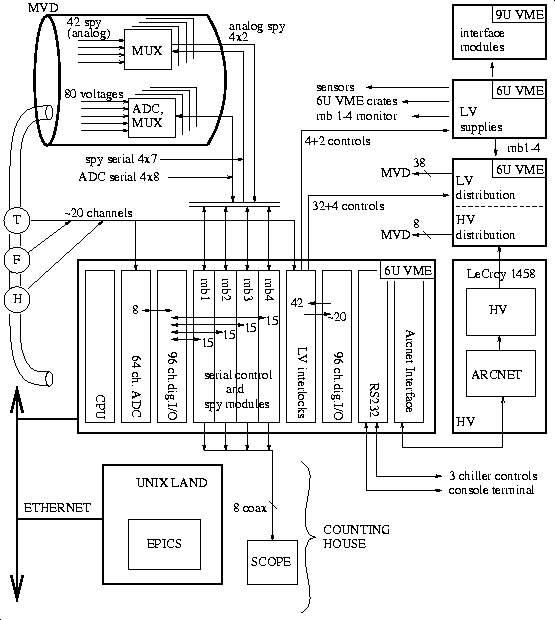SCHEMATIC LAYOUT OF THE MVD ANCILLARY SYSTEMS
Last update: 4 Sep 98 - HvH

Logically, the MVD can be divided into east and west halves, and each half is read out to its north and south ends. Thus here are 4 motherboards with connections to the outside world.
Crates and rack: MVD ancillary systems will be housed in several crates.
The main
crate shown above is a 6U VME crate, with a VME CPU (any cpu that runs VxWorks).
Here is the physical layout
There is a second 6U VME crate, which houses the LV and HV power distribution.
The second crate has no CPU, since the distribution modules are mostly
passive.
Here is the physical layout
A third 6U VME crate houses the LV supplies.
Here is the physical layout
The LV modules, as well as all other crates in the rack, are inder the control
of the
rack monitoring system.
It is not yet clear how detailed the LV control will be.
Here are 3 views of the MVD rack and it's
contents,
and this picture shows
where the rack is placed in the hall.
Digital I/O: There are several modules which need to be controlled or read out via digital I/O. We will handle our digital I/O with an IP carrier board (Greenspring VIPC616), holding 4 24-channel digital I/O modules (Greenspring IP-Digital 24).
RS232 I/O: The 3 chillers in our cooling system are controlled via RS232
ports. We will have a second IP carrier board, holding one 8-port RS232
Industry Pack (Greenspring IP-Octal Opto
). We will use 3 ports for the chillers, and one for a dumb terminal
console. [external +12, -12 or +5 power may be needed for opto-iso use -
question submitted to Greenspring].
The remaining 3 slots on the carrier will be used by more digital I/O modules,
since the first IP carrier only holds 4x24 digital channels, and we need
roughly 110.
MVD on-board ADC's: In each quarter, there are 42 MCM temperature sensors, and 35 LDO voltages to be read out. In addition, the temperature at 3 locations on the motherboard is monitored, for a total of 80 voltages per quarter. There is not enough space to feed 80 signals out, so they are converted by scanning ADC's on the motherboard, multiplexed together and fed out over a serial link, one per motherboard. The 4x8 serial lines (as well as other lines described later) go down to the modules labeld 'control and spy' in the 6U VME crate. They are passively passed on to the digital I/O module, which is controlled by a C-program running in the crate's CPU, (much as we currently talk to the Xilinxes in the clean tent). Details on a separate page.
Custom ADC board and external sensors: There are several more analog signals generated by temperature, flow and humidity probes located on or near the cooling units, which we will handle with a custom ADC module which is essentially a copy of the circuitry on the motherboards. External sensor hardware can be found here.
MCM spy lines:Each MCM also has 2 analog spy lines, one connected to the preamp output and one to the AMU output, for a total of 42x2 per quarter. These signals are multiplexed on the motherboard, so that only 2 analog lines per quarter are fed out. The analog switches on the motherboard are controlled by 7 digital lines per quarter. Details here. The 4x7 digital control lines are also passed on by the control and spy modules to the digital I/O module. The analog signals themselves are received on the control and spy modules, where they are optically isolated and sent to the control room over 8 coax cables by these chips.
Power supply interlock module:(Also called the 'relay board')
This board contains the hardwired
logic that shuts parts of the MVD off if a threatening condition is detected
on the input sensors. In addition, these functions can be controlled from the
computer via 42 I/O lines from a second 96-channel digital I/O board.
Some output lines switch the power supplies indirectly, via the
rack monitoring system.
The locig on the relay board is determined using
these fault charts.
High Voltage:The Black Box will also contain the interface (Compcontrol
CC121-FH/L)
to the standard Phenix HV system (LeCroy 1458). Through this interface the
units in the separate HV crate are controlled.
A patch panel is needed to convert the HV supply cables/connectors to the
cables/connectors which go up to the MVD. The patch panels, called MV HV
power distribution modules, are
in the second, passive, ancillary crate
Low Voltage:The power supplies are housed in a separate crate.. From there, power goes up to the LV power distribution modules, housed in the second ancillary VME crate. From there power goes up to the MVD. This is the mapping from supply to distribution
Radiation monitors:There will be (approximately) 10 pin-diode radiation monitors, 4 on each pole face and 2 near the beam pipe at z=0. These will be in place before the MVD is installed to characterize the radiation environment. The central ones will be removed when the MVD arrives, but the 8 on the pole faces will remain in place. Each unit has its own amp and discriminator, and the signals go to scalers in the Black Box, which makes the counts available to EPICS.
In addition the box provides low voltage to the crate which houses the MVD interface boards (DCM, timing, control, trigger inerface modules), and power to the external sensors. These low-voltage are likely to be 8 double-wide 6U modules. There is no room in the crate for all this, so the LV modules will be housed in a physically separate crate, but logically connected by a VME extender connection.